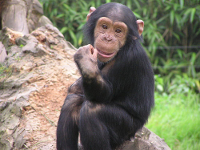SIV, the simian form of HIV, causes illness in chimpanzees similar to human AIDS, despite the longstanding belief that such viruses had no effect on non-humans primates, according to a new study published this week in Nature.
"It's definitely unexpected," said viral immunologist Don Sodora of the Seattle Biomedical Research Institute, who was not involved in the research. "Prior to this it was thought that when African apes and monkeys were infected with SIV, there was no clinical disease."
For nearly a decade, researchers have closely observed three free-living chimpanzee communities at the Gombe National Park in Tanzania -- home to the legendary work of primatologist Jane Goodall. More than 40 different SIVs naturally occur in dozens of African primate species, but they were universally believed to be virtually harmless. Linking viral infections in wild primates to slow-acting diseases such as AIDS is difficult, and captive, naturally infected chimpanzees did not show the characteristic decline in T-cell counts common in humans with AIDS. However, when AIDS researcher Beatrice Hahn of the University of Alabama at Birmingham and her colleagues noticed that chimps infected with SIVcpz -- the immediate evolutionary precursor to HIV-1 -- did not live as long as virus-free chimps, they started to question this longstanding assumption.
"We saw that the number of chimps who had died in the infected group was about three times the number of chimps who had died in the uninfected group," Hahn said. "That was the first thing that really jolted us."
That spurred Hahn to do a more formal mortality analysis. She found that chimps infected with SIVcpz were 10-16 times more likely to die in any given year than their uninfected group mates. Furthermore, fewer SIV-infected females gave birth to offspring, and none of the offspring born to infected mothers lived for more than a year.
The team followed up these life history analyses with post-mortem histological investigations of three infected and two uninfected chimps, looking for "the tell-tale signs that had previously been described in humans with HIV-1 infection," Hahn said. Indeed, the infected individuals showed "hallmarks of HIV-1 infection," Hahn said, suggesting that chimps who contract SIVcpz in this population fall victim to an AIDS-like disease.
All infected chimps had lower CD4+ T-cell counts and increased collagen deposition -- a sign of chronic immune activation -- in the spleen. In addition, the infected chimp with the most profound CD4+ T-cell depletion also showed lower counts other types of T cells, suggesting a more advanced form of the disease. That particular individual died less than three years after contracting SIVcpz, and became extremely thin and weak on the days leading up to her death.
"Thanks to these painstaking behavioral studies and tracking of chimps in Jane Goodall's reserve, [the researchers] have been able to make these life tables and see that on average the chimps with SIV live shorter lives and are less fertile," said virologist Robin Weiss of the University College London, who was not involved in the work but wrote an accompanying review of the study. In addition, "the pathology looks vaguely like AIDS in humans."
The magnitude of the SIV-induced illness is still unclear. SIVcpz appears to be less pathogenic than HIV-1, which increases the risk of death 18-20-fold in infected humans. One possible explanation for this difference is that SIVcpz and its chimp hosts have been coevolving for an estimated 500 years -- about five times longer than the 100 years since HIV jumped into humans. More time means more opportunity for the host to evolve mechanisms to cope with its unwanted invader. Additionally, 500 years is a relatively long time compared with other primate species affected by SIVs, which may explain why these chimps are getting sick at all, while others do not show any signs of illness, Hahn said.
Regardless of the reason, "having a gradient of disease progression could potentially allow us the ability to figure out why some monkey species get sick and some don't," Sodora said. Identifying this pathogenic effect of an HIV-related virus in a species so closely related to humans "may give us a clue on how HIV-1 works," Hahn agreed.

Source
No comments:
Post a Comment